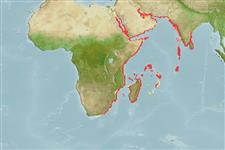Пластиножаберные (акулы и скаты) (sharks and rays) >
Rhinopristiformes (Shovelnose rays) >
Rhinidae (Wedgefishes)
Etymology: Rhynchobatus: Greek, rhingchos = snout + Greek, batis, -idos = a sting ray (Raja sp.) (Ref. 45335).
More on author: Forsskål.
Environment: milieu / climate zone / пределы глубины / distribution range
экология
морской; солоноватоводный ассоциированный с рифами; пределы глубины 1 - 75 m (Ref. 106604). Tropical; 35°N - 35°S, 22°E - 83°E
Western Indian Ocean: restricted to the Red Sea and the tropical western Indian Ocean to South Africa. Also reported from Persian Gulf (Ref. 68964). Apparently misidentified with closely related species in the northern and eastern Indian Ocean and western Pacific (however, Ref. 5978 seems to present a reliable record from western Indonesia).
Length at first maturity / Size / Вес / Возраст
половая зрелость: Lm ?, range 177 - ? cm
Max length : 310 cm TL самец/пол неопределен; (Ref. 5578); наибольший вес (опубликованные данные): 227.0 kg (Ref. 3919)
Краткое описание
определительные ключи | морфология | морфометрия
A large guitarfish with large black eyespots on the pectoral bases, a distinctive black cross between the eyes, and rows of small white spots on the upper body; snout pointed and lower caudal lobe short (Ref. 5578). Olive-green above, white below (Ref. 5578). Mouths small and contain flattened, pavement-like teeth.
Body shape (shape guide): elongated.
Occurs inshore and in shallow estuaries (Ref. 5578). Feeds on crabs, lobsters, bivalves, small fishes (Ref. 5578) and squids (Ref. 37816). Ovoviviparous (Ref. 50449). Takes crayfish and pilchard bait. Meat and fins sought after in Asian markets (Ref. 30573).
Exhibit ovoviparity (aplacental viviparity), with embryos feeding initially on yolk, then receiving additional nourishment from the mother by indirect absorption of uterine fluid enriched with mucus, fat or protein through specialised structures (Ref. 50449). With 4 young, about 43-60 cm in length (Ref. 37816), born in the summer (Ref. 3919).
Compagno, L.J.V., 1986. Rhinobatidae. p. 128-131. In M.M. Smith and P.C. Heemstra (eds.) Smiths' sea fishes. Springer-Verlag, Berlin. (Ref. 3919)
Статус Красного Списка МСОП (Ref. 130435: Version 2025-1)
Угроза для людей
Harmless
Использование человеком
рыболовство: коммерческий; объект спортивного рыболовства: да; аквариум: общественные аквариумы
дополнительная информация
инструменты
Специальные отчеты
Скачать в формате XML
ресурсы в Интернет
Estimates based on models
Preferred temperature (ссылка
123201): 24.5 - 29.3, mean 27.1 °C (based on 304 cells).
Phylogenetic diversity index (ссылка
82804): PD
50 = 0.5024 [Uniqueness, from 0.5 = low to 2.0 = high].
Bayesian length-weight: a=0.00372 (0.00163 - 0.00845), b=3.11 (2.91 - 3.31), in cm total length, based on LWR estimates for this (Sub)family-body shape (Ref.
93245).
Trophic level (ссылка
69278): 3.6 ±0.6 se; based on diet studies.
устойчивость к внешним воздействиям (ссылка
120179): низкий, минимальное время удвоения популяции 4.5-14 лет (Fec assumed to be <100).
Prior r = 0.28, 95% CL = 0.18 - 0.42, Based on 1 data-limited stock assessment.
Fishing Vulnerability (Ref.
59153): Very high vulnerability (90 of 100).
🛈
Climate Vulnerability (Ref.
125649): High to very high vulnerability (71 of 100).
🛈
Nutrients (Ref.
124155): Calcium = 7.69 [1.43, 29.34] mg/100g; Iron = 0.324 [0.076, 0.901] mg/100g; Protein = 19.9 [17.7, 22.1] %; Omega3 = 0.0794 [, ] g/100g; Selenium = 43.4 [12.2, 120.5] μg/100g; VitaminA = 20.3 [6.7, 58.7] μg/100g; Zinc = 0.733 [0.359, 1.509] mg/100g (wet weight);
